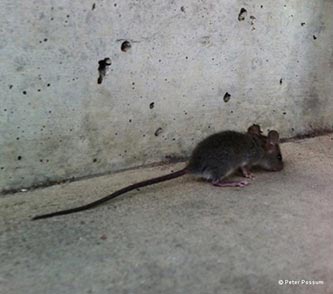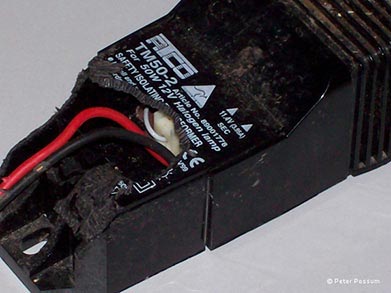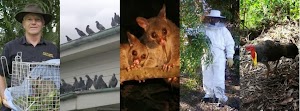1. ANIMAL DESCRIPTION
Common name : House Mouse
Scientific name : Mus musculus
SIZE
House mice have an adult body length of 75 to 100mm and a tail length of 50 to 100mm.
WEIGHT
Adult weight when fully grown is around 10 to 25 grams.
COAT
Has a fur coat that can vary in colour from white to grey and light brown to black. They have short hair and a light coloured abdomen. Their ears and tail have little hair compared to the rest of their body.
FEATURES
The gender is usually difficult to identify as their reproductive organs are not normally externally obvious. However when they become sexually mature adults the male’s testicles do appear extremely large compared with the rest of the size of the body. The male can retract his testicles into his body as required. The females of the species are born with 5 pairs of mammary glands while the male has no nipples.

Mouse Running Along Stairs
2. ECOLOGY
The diet is based upon plant matter i.e. seeds, grains, grass, foliage, vegetables and the like but will also include meat if the opportunity arises thus making the house mouse an omnivore. They have been known to consume their own droppings which benefits their digestive system. The droppings contain nutrients produced by bacteria in their intestines which in turn improves their digestive system.
House mice are noted as being poor competitors with other species of rodents and other small creatures. They generally cannot survive away from human settlements in areas where other small mammals are present as they do not compete well for food or shelter. When mice and rats are found in the same area the mice will exhibit total fear of the rats. The rats will kill and eat the mice. This rat behaviour where a larger rodent preys upon a smaller rodent is referred to as muricide.
3. BEHAVIOUR
They run on all four legs. In certain circumstances the house mouse will resort to standing on its hind legs when reaching to find food or eating, fighting a rival or looking around to orientate themselves in their current location. When the house mouse stands on its hind legs it will support itself with its tail.
They have been observed climbing and swimming and they are fantastic jumpers. They can jump vertically up to 450mm which is considerable compared to its body size.
It is mostly active during night time mainly to avoid predators. They favour living near good food sources in a variety of hidden locations. House mice will construct their nests from a variety of soft organic or synthetic materials that they shred to make a cozy lined nest.
They are a territorial species and a typical family group is lead by a single dominant male. The dominant male usually lives with several females and their young.
The dominant male from one group will respect another male’s territory and will not normally enter another male’s territory as a general rule. It has been recorded that if two or more males are held together in a cage they will turn aggressive and attack each other to sort out who is dominant. The exception to this rule occurs if the males have been raised together from birth, then they will not see each other as fierce competitors.
4. BREEDING
The female has a breeding cycle that lasts between 4 to 6 days. The actual optimum time for the female to conceive is actually only one day in that cycle phase.
It has been observed that if a larger group of females are held in a small contained area then none of the females will experience a breeding cycle. They shut down their fertility due to overcrowding. This may be attributed to their biological system identifying an over population of mice and a lack of food sources or living space.
However if the house mouse females are exposed to the urine of the male, they will come into season within a 72 hour period of being exposed to the urine. The strong odour of the adult male’s urine (pheromones) can speed up sexual maturation in juvenile females and synchronise reproductive cycles in mature females.
The house mouse relies on their pheromones for social communication which is produced by the preputial glands of both genders, and found in both tear fluid and urine. They will detect the pheromones of other mice with their vomeronasal organ located at the bottom of their noses.
The male will court the female by calling to the females with an ultrasonic noise in the 30 kHz to 110 kHz range. These calls are most common during the courtship ritual when the male uses his sense of smell to locate and follow a hopefully receptive female. The male continues these ultrasonic calls after the mating has begun and they become synchronised with calls from the female.
After the male and female have concluded their copulation the female house mouse will develop a copulation plug. This plug is a natural way to physically prevent any further copulation from other males. The copulation plug lasts for 24 hours before disbanding.
The gestation period after a successful mating is around 19 to 21 days. The female will give birth to a litter consisting of 3 to 14 young. The average litter is around 6 to 8 young though. On average a single female house mouse can have anywhere from 5 to 10 litters in a single calendar year. From this basic calculation one female can produce around 40 to 80 baby mice in 1 year. So it is no surprise that the population can increase very quickly (as with any mouse population).
They will breed all year round regardless of weather conditions while other mouse species tend not to breed in the colder months.
The newborn mice are born “blind” and without any fur. Their fur starts to grow around three days after their birth. Their eyes will open anywhere from one to two weeks after the birth.
The male of the species will usually reach sexual maturity around 6 weeks of age and the female around 8 weeks. But they can commence breeding at the age of just 5 weeks.
Comparisons and differences between Mice and Rats
A) Behaviour and Ecology
The rat has a larger body and features. The mouse has finer facial features and limbs compared to the rat. The rat is a more “confident” extroverted creature than the passive and introverted mouse. The presence of a rat is usually seen by humans as they forage in full view where a mouse is usually hidden away from view and is keen to go unnoticed by anyone or anything.
The rat is an accomplished swimmer and will have no second thoughts when taking to water to find food or escape predators and other threats. The mouse however is not an established swimmer and is not competent when faced with water. The mouse will rarely consider swimming. The rat is a great climber and will scale many different materials where the mouse is not an accomplished climber. The rat is a keen digger and will tunnel extensively to create a home for its clan. The mouse does not dig because it prefers to find nooks, holes and hollows to set up home for its nest.
The rat is a specialist communicator as it uses ultrasonic vocalization between its fellow rats. The mouse does not use ultrasonic communication but rather simple squeaks and chirps. The rat has been recorded going to great lengths to source food. For example, in Italy it has been seen diving into water to uncover living molluscs on rocks to eat. It has also been recorded diving for live fingerling fish in the USA. The mouse is an opportunistic feeder that forages for food where it finds it either hidden or readily available within its small territorial boundaries.
Mice are afraid of rats as a rat will attack, kill and eat a mouse.

Electricals Chewed By Mice
5. HOME OWNER PROBLEMS
The common house mouse typically lives in close vicinity to human beings and their houses or places of work. They can cause physical damage to a home and its contents plus spread unwanted diseases to the inhabitants. The mouse can chew through walls and cupboards to gain unwanted entry. House mice can transmit diseases and can damage food and food packaging. The house mouse can carry the same diseases as rats (Leptospirosis, Murine typhus, Rickettsialpox).
Leptospirosis is also called Weil’s disease. Though recognized among the world’s most common diseases transmitted to people from animals, leptospirosis is nonetheless a relatively rare bacterial infection in humans. This infection is commonly transmitted to humans by allowing water that has been contaminated by animal urine to come in contact with unhealed breaks in the skin such as cuts and abrasions, human eyes, or with the mucous membranes of the nose.
Outside of tropical areas, leptospirosis cases have a relatively distinct seasonality with most of them occurring in the spring and autumn. In the Brisbane area it has been noted as a minor risk to humans. Although it is not common it can have devastating effects on humans.
Historians claim that the primary reason for the taming of the domestic feline cat was due to the need for home owners to cull the mice in their homes.
6. SUMMARY – HOW CAN PETER THE POSSUM MAN HELP YOU?
If you have a mouse problem or a serious infestation of mice in your home, office or place of work and are in need of mouse control then Peter the Possum Man offers the following services for Brisbane mice problems and rodent control. Peter the Possum Man will get rid of mice as you require.
Call Peter the Possum Man and ask for the specialist Brisbane mouse and rodent controller. All of our staff are highly trained pest controllers who will get rid of your unwanted pest guests promptly and efficiently. Our company has over 25 years of experience and knows all of the techniques on how to remove, kill and control mice in Brisbane today.
Mouse control and getting rid of mice successfully is a professional pest controller’s task.
So once again – if you have a mice control or rodent control problem, call Peter the Possum Man to get rid of mice. The Possum Man is a licensed registered professional rodent controller and as such they have access to the stronger baits that can only be laid by a licensed pest controller.
Peter the Possum Man recommends these stronger more effective baits for use around people’s houses and gardens. We use specialized plastic bait boxes which are lockable to keep these baits away from family loved ones such as pets and children. Safety first!







